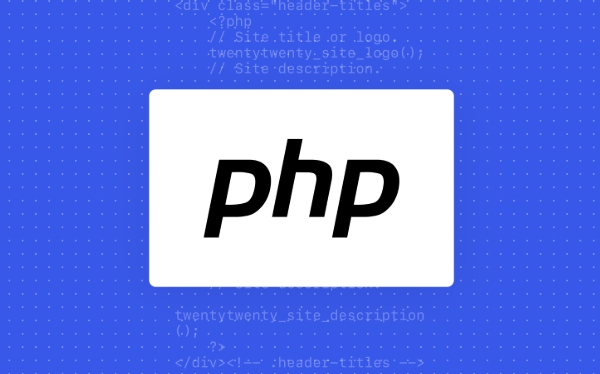Each class or function should only be responsible for a single function, which is convenient for independent testing; 2. Use dependency injection to avoid hard-coded dependencies, which is convenient for replacing with mock objects; 3. Try to write pure functions without side effects to improve testability; 4. Unit tests should be isolated and fast, avoiding dependency on databases or APIs through simulation; 5. Use clear naming and reasonable directory structure to follow PSR standards; 6. Prefer tests (such as TDD) to promote code design; 7. Avoid static methods and global states and encapsulate them for replacement. Following these principles can significantly improve the maintainability, predictability, and testability of your code, ultimately reducing defect rates and accelerating teamwork.

Writing clean and testable PHP code isn't just about making your application work — it's about making it maintainable, predictable, and easier to debug. Whether you're building a small script or a large-scale application, the quality of your codebase directly impacts long-term success. Here's how to write PHP code that's both clean and testable.

1. Follow the Single Responsibility Principle (SRP)
Each class or function should have one clear purpose. When a class does too many things, it becomes hard to test and harder to change without breaking something.
Example:

// Bad: Does multiple things
class UserProcessor {
public function processUser($data) {
$this->validate($data);
$this->saveToDatabase($data);
$this->sendEmail($data);
}
} // Good: Each class has one job
class UserValidator {
public function validate($data) { /* ... */ }
}
class UserRepository {
public function save($data) { /* ... */ }
}
class UserMailer {
public function sendWelcomeEmail($user) { /* ... */ }
} Now you can test UserValidator independently without worrying about database or email side effects.
2. Use Dependency Injection (DI)
Hardcoding dependencies make testing difficult because you can't easily replace real services (like a mailer or database) with mocks.

Instead of:
class UserService {
private $mailer;
public function __construct() {
$this->mailer = new Mailer(); // Hardcoded
}
}Do this:
class UserService {
private $mailer;
public function __construct(MailerInterface $mailer) {
$this->mailer = $mailer;
}
}Now in tests, you can inject a mock:
$mailer = $this->createMock(MailerInterface::class); $mailer->expects($this->once())->method('send'); $userService = new UserService($mailer);
This makes your code flexible and decoupled.
3. Write Pure Functions When Possible
A pure function always returns the same output for the same input and has no side effects. These are much easier to test.
Example:
function calculateTax(float $amount, float $rate): float {
return $amount * $rate;
}This can be tested with simple assertions:
$this->assertEquals(10, calculateTax(100, 0.1));
Avoid functions that rely on globals, static state, or modify external variables.
4. Keep Tests Isolated and Fast
Unit tests should run quickly and not depend on external systems like databases or APIs.
- Use mocks and stubs to simulate external dependencies.
- Avoid hitting the database in unit tests — save that for integration tests.
- Use tools like PHPUnit with built-in mocking support.
Example:
public function testUserCreationSendsEmail() {
$repo = $this->createMock(UserRepository::class);
$repo->method('save')->willReturn(1);
$mailer = $this->createMock(MailerInterface::class);
$mailer->expects($this->once())->method('send');
$service = new UserService($repo, $mailer);
$service->register(['email' => 'user@example.com']);
}This test verifies behavior without sending real emails.
5. Organize Code with Meaningful Names and Structure
Clean code should be self-explanatory.
- Use describe function and variable names:
calculateTotal()instead ofcalc(). - Group related classes in directories (eg,
Services/,Repositories/,Validators/). - Follow PSR standards (like PSR-12 for coding style).
Bad:
function proc($d) { /* ... */ }Good:
function processUserData(array $userData): User { /* ... */ }Clear naming reduces the need for comments and makes tests easier to write.
6. Write Tests First (TDD Helps)
Test-Driven Development (TDD) encourages writing tests before implementation. This forces you to think about the interface and behavior upfront.
Steps:
- Write a failing test.
- Write minimum code to pass it.
- Refactor with confidence.
Even if you don't fully adopt TDD, writing tests early helps design cleaner, more modular code.
7. Avoid Static Methods and Global State
Static calls (like DateTime::createFromFormat() ) are OK, but avoid creating your own static service classes (eg, Database::query() ). They're hard to mock and create hidden dependencies.
Global functions like time() , rand() , or file_get_contents() introduce side effects. If you need them, wrap them in a service so they can be replaced in tests.
interface Clock {
public function now(): DateTime;
}
class SystemClock implements Clock {
public function now(): DateTime {
return new DateTime();
}
}Now you can control “time” in tests by injecting a fake clock.
Final Thoughts
Clean and testable PHP code comes down to:
- Separation of concerns
- Dependency injection
- Minimizing side effects
- Writing isolated, fast tests
- Using meaningful abstractions
It might take a little more effort upfront, but it pays off in fewer bugs, easier refactoring, and faster onboarding for new developers.
Basically, if your code is easy to test, it's probably clean. If it's a pain to test, it's telling you something needs to change.
The above is the detailed content of The Art of Writing Clean and Testable PHP Code. For more information, please follow other related articles on the PHP Chinese website!

Hot AI Tools

Undress AI Tool
Undress images for free

Undresser.AI Undress
AI-powered app for creating realistic nude photos

AI Clothes Remover
Online AI tool for removing clothes from photos.

Clothoff.io
AI clothes remover

Video Face Swap
Swap faces in any video effortlessly with our completely free AI face swap tool!

Hot Article

Hot Tools

Notepad++7.3.1
Easy-to-use and free code editor

SublimeText3 Chinese version
Chinese version, very easy to use

Zend Studio 13.0.1
Powerful PHP integrated development environment

Dreamweaver CS6
Visual web development tools

SublimeText3 Mac version
God-level code editing software (SublimeText3)
 PHP Variable Scope Explained
Jul 17, 2025 am 04:16 AM
PHP Variable Scope Explained
Jul 17, 2025 am 04:16 AM
Common problems and solutions for PHP variable scope include: 1. The global variable cannot be accessed within the function, and it needs to be passed in using the global keyword or parameter; 2. The static variable is declared with static, and it is only initialized once and the value is maintained between multiple calls; 3. Hyperglobal variables such as $_GET and $_POST can be used directly in any scope, but you need to pay attention to safe filtering; 4. Anonymous functions need to introduce parent scope variables through the use keyword, and when modifying external variables, you need to pass a reference. Mastering these rules can help avoid errors and improve code stability.
 How to handle File Uploads securely in PHP?
Jul 08, 2025 am 02:37 AM
How to handle File Uploads securely in PHP?
Jul 08, 2025 am 02:37 AM
To safely handle PHP file uploads, you need to verify the source and type, control the file name and path, set server restrictions, and process media files twice. 1. Verify the upload source to prevent CSRF through token and detect the real MIME type through finfo_file using whitelist control; 2. Rename the file to a random string and determine the extension to store it in a non-Web directory according to the detection type; 3. PHP configuration limits the upload size and temporary directory Nginx/Apache prohibits access to the upload directory; 4. The GD library resaves the pictures to clear potential malicious data.
 Commenting Out Code in PHP
Jul 18, 2025 am 04:57 AM
Commenting Out Code in PHP
Jul 18, 2025 am 04:57 AM
There are three common methods for PHP comment code: 1. Use // or # to block one line of code, and it is recommended to use //; 2. Use /.../ to wrap code blocks with multiple lines, which cannot be nested but can be crossed; 3. Combination skills comments such as using /if(){}/ to control logic blocks, or to improve efficiency with editor shortcut keys, you should pay attention to closing symbols and avoid nesting when using them.
 How Do Generators Work in PHP?
Jul 11, 2025 am 03:12 AM
How Do Generators Work in PHP?
Jul 11, 2025 am 03:12 AM
AgeneratorinPHPisamemory-efficientwaytoiterateoverlargedatasetsbyyieldingvaluesoneatatimeinsteadofreturningthemallatonce.1.Generatorsusetheyieldkeywordtoproducevaluesondemand,reducingmemoryusage.2.Theyareusefulforhandlingbigloops,readinglargefiles,or
 Tips for Writing PHP Comments
Jul 18, 2025 am 04:51 AM
Tips for Writing PHP Comments
Jul 18, 2025 am 04:51 AM
The key to writing PHP comments is to clarify the purpose and specifications. Comments should explain "why" rather than "what was done", avoiding redundancy or too simplicity. 1. Use a unified format, such as docblock (/*/) for class and method descriptions to improve readability and tool compatibility; 2. Emphasize the reasons behind the logic, such as why JS jumps need to be output manually; 3. Add an overview description before complex code, describe the process in steps, and help understand the overall idea; 4. Use TODO and FIXME rationally to mark to-do items and problems to facilitate subsequent tracking and collaboration. Good annotations can reduce communication costs and improve code maintenance efficiency.
 How to access a character in a string by index in PHP
Jul 12, 2025 am 03:15 AM
How to access a character in a string by index in PHP
Jul 12, 2025 am 03:15 AM
In PHP, you can use square brackets or curly braces to obtain string specific index characters, but square brackets are recommended; the index starts from 0, and the access outside the range returns a null value and cannot be assigned a value; mb_substr is required to handle multi-byte characters. For example: $str="hello";echo$str[0]; output h; and Chinese characters such as mb_substr($str,1,1) need to obtain the correct result; in actual applications, the length of the string should be checked before looping, dynamic strings need to be verified for validity, and multilingual projects recommend using multi-byte security functions uniformly.
 Quick PHP Installation Tutorial
Jul 18, 2025 am 04:52 AM
Quick PHP Installation Tutorial
Jul 18, 2025 am 04:52 AM
ToinstallPHPquickly,useXAMPPonWindowsorHomebrewonmacOS.1.OnWindows,downloadandinstallXAMPP,selectcomponents,startApache,andplacefilesinhtdocs.2.Alternatively,manuallyinstallPHPfromphp.netandsetupaserverlikeApache.3.OnmacOS,installHomebrew,thenrun'bre
 Learning PHP: A Beginner's Guide
Jul 18, 2025 am 04:54 AM
Learning PHP: A Beginner's Guide
Jul 18, 2025 am 04:54 AM
TolearnPHPeffectively,startbysettingupalocalserverenvironmentusingtoolslikeXAMPPandacodeeditorlikeVSCode.1)InstallXAMPPforApache,MySQL,andPHP.2)Useacodeeditorforsyntaxsupport.3)TestyoursetupwithasimplePHPfile.Next,learnPHPbasicsincludingvariables,ech






